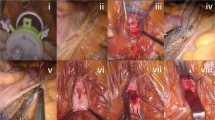Abstract
Objectives
Paravaginal defects have been shown to account for 60–80 % of anterior compartment prolapse and its repair offers the chance of a more effective cure of such defect. There is no good evidence to suggest the superiority of a particular route of paravaginal repair. The objective of this study was to evaluate the effectiveness of abdominal (APVR), vaginal (VPVR) and laparoscopic (LPVR) approaches in the repair of such defects.
Study design
This is a prospective comparative study of patients, referred over a 2-year period, with symptomatic stage II–IV anterior compartment prolapse due to paravaginal support defects. Patients were assessed subjectively by direct verbal questioning, and objectively, using POP-Q system for staging, at 1, 6 and 12 months postoperatively. Analysis of data was performed using SPSS for Windows (V9) software package.
Results
Forty-five patients were recruited to the study. There was no significant difference in the subjective and objective outcomes of APVR (n = 20) and VPVR (n = 20) groups. The laparoscopic approach had to be abandoned after five patients only, as the degree of improvement in prolapse stage was less than in the other two approaches.
Conclusion
The effectiveness of paravaginal repair procedure is similar whether the abdominal or vaginal approaches were adopted in patients with anterior compartment prolapse due to paravaginal support defects. In our experience, the laparoscopic approach was associated with the least favourable outcome.


Similar content being viewed by others
References
Liu CY (1996) Laparoscopic cystocele repair: paravaginal suspension. In: Laparoscopic hysterectomy and pelvic floor reconstruction. Black-well Science, Cambridge, pp 330–340
Weber AM, Walters MD (1997) Anterior vaginal prolapse: review of anatomy and techniques of surgical repair. Obstet Gynecol 89:311–318
Wall L, Walshe CJ (2002) Anterior compartment. In: Stanton SL, Zimmern PE (eds) Female pelvic reconstructive surgery. Springer, Berlin, pp 161–178
Richardson AC (1990) How to correct prolapse paravaginally. Contemp OB Gyn 35(9):100–114
Liu CY (1998) Stress urinary incontinence. In: Hulka JF, Reich H (eds) Textbook of laparoscopy, 3rd edn. WB Saunders company, Philadelphia, pp 329–350
Nichols DH, Randall CL (1996) Choice of operation for genital prolapse. In: Nichols DH, Randall CL (eds) Vaginal Surgery, 4th edn. Williams and Wilkins, Baltimore, pp 119–139
Reid RI, You H, Luo K (2011) Site-specific prolapse surgery. Reliability and durability of native tissue paravaginal repair. Int Urogynecol J 22:591–599
Slack M (2004) Management of prolapse of the anterior compartment. BJOG 111(1):67–72
Jha S, Moran PA (2007) National survey on the management of prolapse in the UK. Neurourol Urodyn 26:325–331
Veronikis DK (2000) Paravaginal defects. In: Nichols DH, Pearson DLC (eds) Gynecologic, obstetric, and related surgery. Mosby, St. Louis, pp 504–517
Paraiso MF, Walters MD (2000) Laparoscopic pelvic reconstructive surgery. Clinical Obstet Gynec 43(3):594–603
Bump RC, Mattiasson A, Bo K, Brubaker LP et al (1996) The standardization of terminology of female pelvic floor dysfunction. Am J Obstet Gynecol 175:10–17
Young SB, Daman JJ, Bony LG (2001) Vaginal paravaginal repair: one year outcomes. Am J Obstet Gynecol 185(6):241–252
Mallipeddi PK, Steele AC, Kohli N, Karram MM (2001) Anatomic and functional outcome of vaginal paravaginal repair in the correction of anterior vaginal wall prolapse. Int Urogynecol J 12:83–88
Viana R, Colaco J, Vieira A, Goncalves V, Retto H (2006) Cystocele-vaginal approach to repairing paravaginal fascial defects. Int Urogynecol J 17:621–623
Morse AN, O’Dell KK, Howard AE, Baker SP, Aronson MP, Young SB (2007) Midline anterior repair alone vs. anterior repair plus vaginal paravaginal repair: a comparison of anatomic and quality of life outcomes. Int Urogynecol J 18:245–249
Segal JL, Vassallo BJ, Kleeman SD, Silva WA, Karram MM (2004) Paravaginal defects: prevalence and accuracy of preoperative detection. Int Urogynecol J 15:378–383
Maggiore ULR, Ferrero S, Mancuso S, Costantini S (2012) Feasibility and outcome of vaginal paravaginal repair using the Capio suture-capturing device. Int Urogynecol J 23:341–347
Richardson AC, Lyons JB, Williams NL (1976) A new look at pelvic relaxation. Am J Obstet Gynecol 126(5):568–573
Richardson AC, Edmonds PB, Williams NL (1981) Treatment of stress urinary incontinence due to paravaginal fascial defect. Obstet Gynecol 57:357
Baden WF, Shull BL (1989) A six year experience with paravaginal defects repairs for stress urinary incontinence. Am J Obstet Gynecol 160:1432–1437
Willison FB, Semen EI, Cook JR, O’Shea RT, Keirse MJNC (2007) Laparoscopic paravaginal repair of anterior compartment prolapse. J Minim Invasive Gynecol 14:475–480
Pantzis K, Freeman R et al (2011) Open and laparoscopic sacrocolpopexy demonstrate clinical equivalence: one year results from the LAS trial. An RCT comparing the two approaches for treating posthysterectomy vault prolapsed. In: 41st annual meeting of the International continence society (ICS). Abstract number 131
Acknowledgments
The authors wish to acknowledge the support of the staff and the patients of Ain Shams University Urogynaecology and Pelvic Reconstructive Surgery Clinic. This work was funded from Ain Shams University Urogynaecology and pelvic reconstructive surgery unit.
Ethical standard
The study was approved by Ain Shams University Hospitals ethics committee and has therefore been performed in accordance with the ethical standards laid down in the 1964 Declaration of Helsinki and its later amendments.
Conflict of interest
None.
Author information
Authors and Affiliations
Corresponding author
Rights and permissions
About this article
Cite this article
Hosni, M.M., El-Feky, A.E.H., Agur, W.I. et al. Evaluation of three different surgical approaches in repairing paravaginal support defects: a comparative trial. Arch Gynecol Obstet 288, 1341–1348 (2013). https://doi.org/10.1007/s00404-013-2927-4
Received:
Accepted:
Published:
Issue Date:
DOI: https://doi.org/10.1007/s00404-013-2927-4




